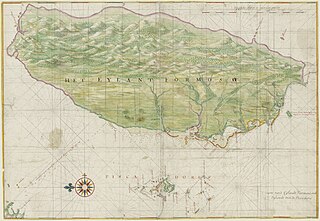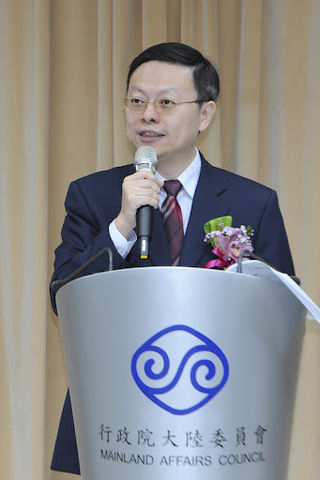Related Research Articles

Chinese unification, also known as Cross-Strait unification or Chinese reunification, is the potential unification of territories currently controlled, or claimed, by the People's Republic of China and the Republic of China ("Taiwan") under one political entity, possibly the formation of a political union between the two republics. Together with full Taiwan independence, unification is one of the main proposals to address questions on the political status of Taiwan, which is a central focus of Cross-Strait relations.
The political status of Taiwan or the Taiwan issue is an ongoing geopolitical dispute about Taiwan, currently controlled by the Republic of China (ROC), that arose in the mid-twentieth century. Originally based in Mainland China before and during World War II, the ROC government retreated to Taiwan in 1949 after the Chinese Communist Party (CCP) won the Chinese Civil War and established the People's Republic of China (PRC). Since then, the effective jurisdiction of the ROC has been limited to Taiwan, Penghu, Kinmen, Matsu, and smaller islands.
One China is a phrase describing the international relationship between the People's Republic of China (PRC), situated on the Chinese Mainland, and the Republic of China (ROC), commonly known as Taiwan. "One China" asserts that there is only one de jure Chinese nation despite the de facto division between the two rival governments in the aftermath of the Chinese Civil War. The term may refer, in alphabetical order, to one of the following:
The Three Links or Three Linkages was a 1979 proposal from the National People's Congress of the People's Republic of China (PRC) to open up postal, transportation, and trade links between mainland China and Taiwan, with the goal of unifying Mainland China and Taiwan.

As a result of the surrender and occupation of Japan at the end of World War II, the islands of Taiwan and Penghu were placed under the governance of the Republic of China (ROC), ruled by the Kuomintang (KMT), on 25 October 1945. Following the February 28 massacre in 1947, martial law was declared in 1949 by the Governor of Taiwan, Chen Cheng, and the ROC Ministry of National Defense. Following the end of the Chinese Civil War in 1949, the ROC government retreated from the mainland as the Chinese Communist Party (CCP) proclaimed the establishment of the People's Republic of China. The KMT retreated to Taiwan and declared Taipei the temporary capital of the ROC. For many years, the ROC and PRC each continued to claim in the diplomatic arena to be the sole legitimate government of "China". In 1971, the United Nations expelled the ROC and replaced it with the PRC.

The Joint Communique of the Government of Japan and the Government of the People's Republic of China was signed on September 29, 1972, in Beijing. The communique established and normalized diplomatic relations between Japan and the People's Republic of China (PRC), resulted in the severing of official relations between Japan and the Republic of China (ROC) in Taiwan. The document produced nine articles in a joint statement, showing compromises on previously ambiguous principles enunciated by both sides. Of these, four points are particularly worthy of attention:
- the desire for a peace treaty between Japan and China;
- the statement that Japan "understands and respects [China's] stance" that Taiwan is part of the PRC;
- an Asia-Pacific anti-hegemony clause;
- Japan's reversal of relations with China and Taiwan.

One Country on Each Side is a concept consolidated in the Democratic Progressive Party government led by Chen Shui-bian, the former president of the Republic of China (2000–2008), regarding the political status of Taiwan. It emphasizes that the People's Republic of China and the Republic of China are two different countries,, as opposed to two separate political entities within the same country of "China". This is the position of the supporters of the Pan-Green coalition.

The Anti-Secession Law is a law of the People's Republic of China, passed by the 3rd Session of the 10th National People's Congress. It was ratified on March 14, 2005, and went into effect immediately. President Hu Jintao promulgated the law with Presidential Decree No. 34. Although the law, at ten articles, is relatively short, Article 8 formalized the long-standing policy of the PRC to use military means against Taiwan independence in the event peaceful means become otherwise impossible. The law does not explicitly equate "China" with the People's Republic of China.
The 1992 Consensus is a political term referring to the alleged outcome of a meeting in 1992 between the semiofficial representatives of the Chinese Communist Party (CCP)-led People's Republic of China (PRC) in mainland China and the Kuomintang (KMT)-led Republic of China (ROC) on Taiwan. They are often credited as creating a diplomatic basis for semi-official cross-strait exchanges which began in the early 1990s and is a precondition set by the PRC for engaging in cross-strait dialogue.

Presidential elections were held in Taiwan on 22 March 2008. Kuomintang (KMT) nominee Ma Ying-jeou won with 58% of the vote, ending eight years of Democratic Progressive Party (DPP) rule. Along with the 2008 legislative election, Ma's landslide victory brought the Kuomintang back to power in the Republic of China.

Cross-strait relations are the political and economic relations between mainland China and Taiwan across the Taiwan Strait.

A cross-strait charter is a charter flight between Taiwan and mainland China, across the Taiwan Strait. After the Chinese Civil War, no direct flights were allowed between Taiwan and mainland China; this remained the case until 2003. Passengers had to transfer in a third city, such as Hong Kong, to complete their trip.

South Korean–Taiwan relations
"Mutual non-recognition of sovereignty and mutual non-denial of authority to govern" is former President of the Republic of China Ma Ying-jeou's description of the relations between the Taiwan Area and Mainland China, as presented in his second inauguration speech after being re-elected in 2012. Sometimes the term special non-state-to-state relations is used in the press for this concept, following his own statements. Ma defines the relations as a "special relationship for which the model of [state] recognition under conventional international law is not applicable". This marks a departure from the views of his predecessors, former presidents Lee Teng-hui's special state-to-state relations and Chen Shui-bian's One Country on Each Side: Both defined the Republic of China (ROC) and the People's Republic of China (PRC) as states and the relationship between the two as one between two states. In Ma's view, the ROC government considers the one China as the ROC, regardless of the view of the PRC government. While neither governing authority can recognize that in the other area as a legitimate state, neither would deny the other side being the de facto governing authority of its area.
The First Chen–Chiang summit was the first of a series of what would later become the Chen-Chiang summit of cross-strait meetings. The meeting was held between the Association for Relations Across the Taiwan Straits (ARATS) represented by Chen Yun-lin and Straits Exchange Foundation (SEF) represented by Chiang Pin-kung. This meeting followed the 1993 Wang-Koo summit.

Relations between the Commonwealth of Australia and the Republic of China, formerly the Qing dynasty, date back to 1909. Since 1972, the political status and legal status of Taiwan have been contentious issues. Australia and Taiwan share partnership in the inter-governmental Global Cooperation and Training Framework (GCTF) activities.

Wang Yu-chi is a Taiwanese politician. He was the Minister of the Mainland Affairs Council (MAC) of the Executive Yuan since 28 September 2012 until 16 February 2015, when he resigned over the dropping of espionage charges brought against Chang Hsien-yao. Wang is the first ROC ministerial-level government official to visit mainland China after the end of the Chinese Civil War in 1949.
The Taiwan Strait Tourism Association is a semi-official representative office of the Republic of China in Mainland China handling tourism-related affairs. Its counterpart body in Taiwan by the People's Republic of China is the Association for Tourism Exchange Across the Taiwan Straits.
In 2014, a series of cross-strait meetings was held between Zhang Zhijun, director of the Chinese government's Taiwan Affairs Office, and Wang Yu-chi, director of Taiwan's Mainland Affairs Council.
The 1998 state visit by Jiang Zemin to Japan was a response to an invitation extended by the Government of Japan to Jiang Zemin of the People's Republic of China for an official visit to Japan as a State Guest from 25 to 30 November 1998. It was also Jiang's second visit to Japan after succeeding General Secretary in 1989, following an earlier visit in April 1992. The goal of this state visit was to create a joint document with a forward-looking character that would set the path for Sino-Japanese relations in the 21st century. The visit was significant because it was the first visit to Japan ever made by the head of state of China. Both governments treated the Japan-China Joint Declaration On Building a Partnership of Friendship and Cooperation for Peace and Development—issued by the two governments on the occasion of visit—as a third important bilateral document, following the 1972 Joint Communiqué and the 1978 Treaty of Peace and Friendship. The two sides repeatedly have stressed that all problems should be handled in line with these three documents. China's expectations for this trip was high because in the previous month, South Korean President Kim Dae-Jung made his state visit to Japan which was considered successful. Despite high expectations, the state visit was considered a failure because Jiang Zemin and Prime Minister of Japan Keizō Obuchi were unable to reach conclusive agreements on matters concerning history, Taiwan, and Japan's permanent membership in the UN Security Council. As a result, the Japanese public and media had a negative view towards Jiang, which ultimately hardened Japan's attitude towards China.